
Coma Berenices is an ancient asterism in the northern sky, which has been defined as one of the 88 modern constellations. It is in the direction of the fourth galactic quadrant, between Leo and Boötes, and it is visible in both hemispheres. Its name means "Berenice's Hair" in Latin and refers to Queen Berenice II of Egypt, who sacrificed her long hair as a votive offering. It was introduced to Western astronomy during the third century BC by Conon of Samos and was further corroborated as a constellation by Gerardus Mercator and Tycho Brahe. It is the only modern constellation named after a historic person.
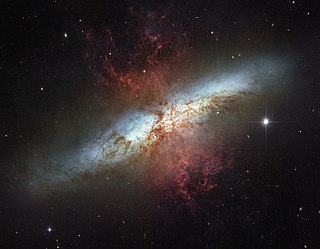
Messier 82 (also known as NGC 3034, Cigar Galaxy or M82) is a starburst galaxy approximately 12 million light-years away in the constellation Ursa Major. It is the second-largest member of the M81 Group, with the D25 isophotal diameter of 12.52 kiloparsecs (40,800 light-years). It is about five times more luminous than the Milky Way and its central region is about one hundred times more luminous. The starburst activity is thought to have been triggered by interaction with neighboring galaxy M81. As one of the closest starburst galaxies to Earth, M82 is the prototypical example of this galaxy type. SN 2014J, a type Ia supernova, was discovered in the galaxy on 21 January 2014. In 2014, in studying M82, scientists discovered the brightest pulsar yet known, designated M82 X-2.

The Pinwheel Galaxy is a face-on, unbarred, and counterclockwise spiral galaxy located 21 million light-years from Earth in the constellation Ursa Major. It was discovered by Pierre Méchain in 1781 and was communicated that year to Charles Messier, who verified its position for inclusion in the Messier Catalogue as one of its final entries.
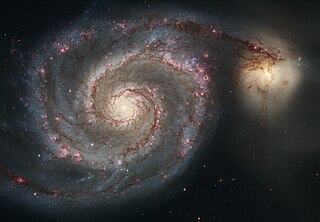
The Whirlpool Galaxy, also known as Messier 51a (M51a) or NGC 5194, is an interacting grand-design spiral galaxy with a Seyfert 2 active galactic nucleus. It lies in the constellation Canes Venatici, and was the first galaxy to be classified as a spiral galaxy. It is 7.22 megaparsecs away and 23.58 kiloparsecs (76,900 ly) in diameter.

NGC 3982(also known as UGC 6918) is an intermediate spiral galaxy approximately 68 million light-years away in the constellation Ursa Major. It was discovered by William Herschel on April 14, 1789, and misclassified as a planetary nebula. NGC 3982 is a part of the M109 Group.
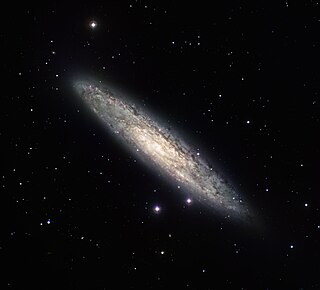
The Sculptor Galaxy is an intermediate spiral galaxy in the constellation Sculptor. The Sculptor Galaxy is a starburst galaxy, which means that it is currently undergoing a period of intense star formation.

NGC 4013 is an edge-on barred spiral galaxy about 55 million light-years away in the constellation Ursa Major. The disk of NGC 4013 shows a distinct "peanut"-shaped bulge in long exposure photographs that N-body computer simulations suggest is consistent with a stellar bar seen perpendicular to the line of sight.
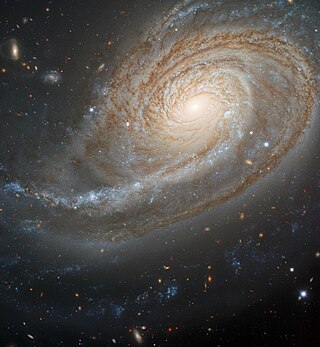
NGC 772 is an unbarred spiral galaxy approximately 106 million light-years away in the constellation Aries. It was discovered on 29 November 1785 by German-British astronomer William Herschel.

NGC 2207 and IC 2163 are a pair of colliding spiral galaxies about 80 million light-years away in the constellation Canis Major. Both galaxies were discovered by John Herschel in 1835.

NGC 5253 is an irregular galaxy in the constellation Centaurus. It was discovered by William Herschel on 15 March 1787.

Arp 220 is the result of a collision between two galaxies which are now in the process of merging. It is the 220th object in Halton Arp's Atlas of Peculiar Galaxies.

NGC 7252 is a peculiar galaxy resulting from an interaction between two galaxies that started a billion years ago. It is located 220 million light years away in the constellation Aquarius. It is also called Atoms for Peace Galaxy, a nickname which comes from its loop-like structure, made of stars, that resembles a classic diagram of an electron orbiting an atomic nucleus.
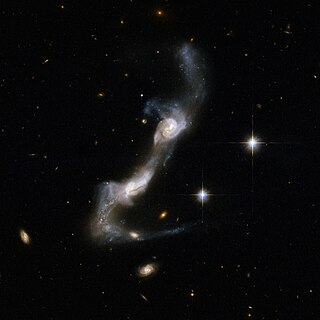
UGC 8335 is a pair of strongly interacting spiral galaxies. They have been distorted by extreme tidal forces, creating prominent tidal tails and a bridge of gas and stars between the galaxies.
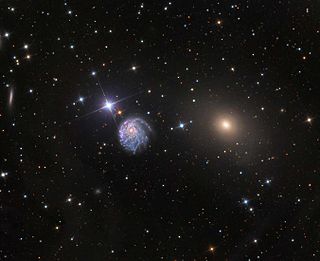
NGC 2276 is an intermediate spiral galaxy in the constellation Cepheus. The galaxy lies 120 million light-years away from Earth. NGC 2276 has an asymmetrical appearance, most likely caused by gravitational interactions with its neighbor, elliptical galaxy NGC 2300. NGC 2276 is traveling with an orbital velocity of about 968 km/s due to its neighbor. Trailing NGC 2276 is a long tail of interstellar medium about 300,000 light-years long, formed by ram pressure stripping.
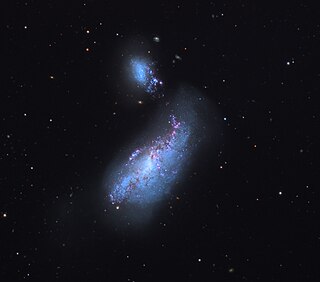
NGC 4490, also known as the Cocoon Galaxy, is a barred spiral galaxy in the constellation Canes Venatici. William Herschel discovered it in 1788. It is known to be of the closest interacting/merging galactic system. The galaxy lies at a distance of 25 million light years from Earth making it located in the local universe. It interacts with its smaller companion NGC 4485 and as a result is a starburst galaxy. NGC 4490 and NGC 4485 are collectively known in the Atlas of Peculiar Galaxies as Arp 269. The two galaxies has already made their closest approach and are rushing away from each other. It's been discovered that NGC 4490 has a double nucleus.

NGC 4424 is a spiral galaxy located in the equatorial constellation of Virgo. It was discovered February 27, 1865 by German astronomer Heinrich Louis d'Arrest. This galaxy is located at a distance of 13.5 million light years and is receding with a heliocentric radial velocity of 442 km/s. It has a morphological class of SB(s)a, which normally indicates a spiral galaxy with a barred structure (SB), no inner ring feature (s), and tightly-wound spiral arms (a). The galactic plane is inclined at an angle of 62° to the line of sight from the Earth. It is a likely member of the Virgo Cluster of galaxies.

NGC 2623(also known as ARP 243) is an interacting galaxy located around 263 million light-years away in the constellation Cancer. It was discovered on 19 January 1885 by French astronomer Édouard Jean-Marie Stephan.

NGC 6621 is an interacting spiral galaxy in the constellation Draco. It lies at a distance of about 260 million light-years. NGC 6621 interacts with NGC 6622, with their closest approach having taken place about 100 million years ago. The pair was discovered by Edward D. Swift and Lewis A. Swift on June 2, 1885. Originally NGC 6621 was assigned to the southeast galaxy, but now it refers to the northern one. NGC 6621 and NGC 6622 are included in the Atlas of Peculiar Galaxies as Arp 81 in the category "spiral galaxies with large high surface brightness companions".

NGC 3656 is a peculiar galaxy formed by the collision of two galaxies in the constellation of Ursa Major. It is located about 135 million light years away from Earth, which means, given its apparent dimensions, that NGC 3656 is approximately 70,000 light years across. It was discovered by William Herschel on April 14, 1789.
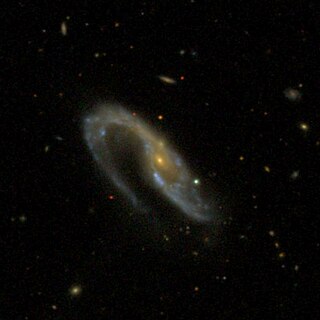
NGC 3509 known as Arp 335, is a barred spiral galaxy located in the constellation Leo. It is located 340 million light-years from the Solar System. NGC 3509 was discovered by astronomer William Herschel on December 30, 1786.




















